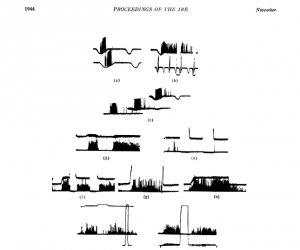
We have described each of the operations on the retinal image in terms of what common factors in a large variety of stimuli cause response and what common factors have no effect. What, then, does a particular fiber in the optic nerve measure? We have considered it to be how much there is in a stimulus of that quality which excites the fiber maximally, naming that quality.
The operations thus have much more the flavor of perception than of sensation if that distinction has any meaning now. That is to say that the language in which they are best described is the language of complex abstractions from the visual image. We have been tempted,for example, to call the convexity detectors “bug perceivers.” Such a fiber [operation 2] responds best when a dark object, smaller than a receptive field, enters that field, stops, and moves about intermittently thereafter. The response is not affected if the lighting changes or if the background (say a picture of grass and flowers) is moving, and is not there if only the background, moving or still, is in the field. Could one better describe a system for detecting an accessible bug?
What the Frog’s Eye Tells the Frog’s Brain? Lettvin et al, 1940.